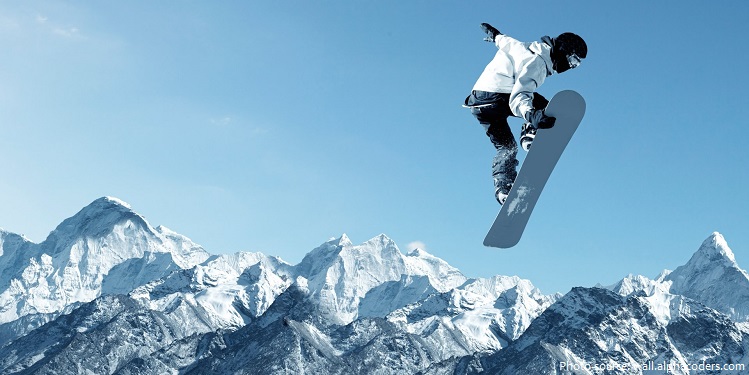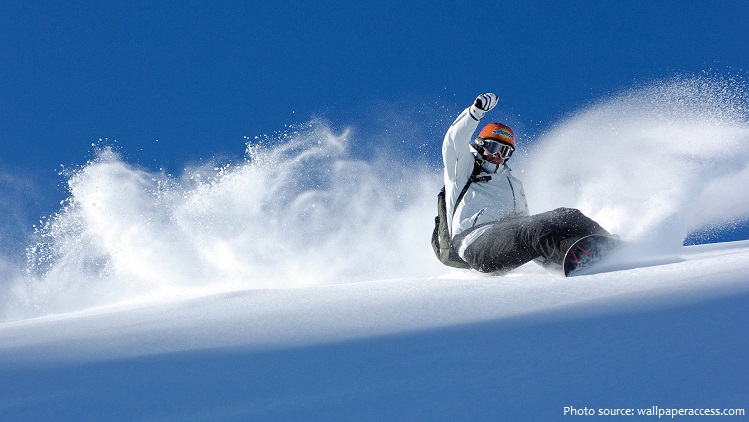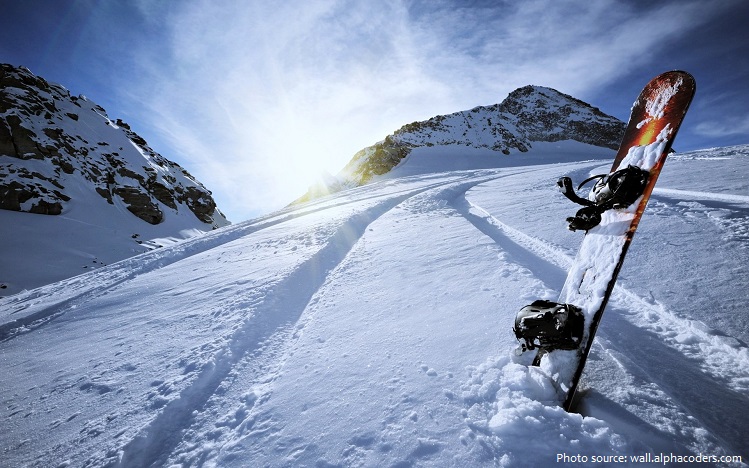
Snowboards are boards where the users places both feet, usually secured, to the same board.
The board itself is wider than most skis, with the ability to glide on snow.
Modern snowboarding began in 1965 when Sherman Poppen, an engineer in Muskegon, Michigan, invented a toy for his daughters by fastening two skis together and attaching a rope to one end so he would have some control as they stood on the board and glided downhill.
Dubbed the “snurfer” (combining snow and surfer) by his wife Nancy, the toy proved so popular among his daughters’ friends that Poppen licensed the idea to a manufacturer, Brunswick Corporation, that sold about a million snurfers over the next decade. And, in 1966 alone, over half a million snurfers were sold.

In 1970, Milovich, an east coast surfer, had an idea while he was sliding around on cafeteria trays in the snow of upstate New York. He started to develop snowboards following the example of the new short surf boards. He even used rudimentary steel edges – an idea he soon gave up because he only rode in deepest powder anyway. He experimented with laminating glass and gravel on the board and also used nylon straps. His company “Winterstick” is to be considered as the first snowboard company ever.
The pioneers were not all from the United States – in 1976, Welsh skateboard enthusiasts Jon Roberts and Pete Matthews developed their own snowboards to use at their local dry ski slope.

Also during this same period, in 1977, Jake Burton Carpenter, a Vermont native who had enjoyed snurfing since the age of 14, impressed the crowd at a Michigan snurfing competition with bindings he had designed to secure his feet to the board. That same year, he founded Burton Snowboards in Londonderry, Vermont. The “snowboards” were made of wooden planks that were flexible and had water ski foot traps. Very few people picked up snowboarding because the price of the board was considered too high at $38 and were not allowed on many ski hills, but eventually Burton would become the biggest snowboarding company in the business. Burton’s early designs for boards with bindings became the dominant features in snowboarding.
In 1985, James Bond popularized snowboarding in the movie A View to a Kill. In the scene, he escapes Soviet agents who are on skis with a makeshift snowboard made from the debris of a snowmobile that exploded. The actual snowboard used for the stunt was a Sims snowboard ridden by founder Tom Sims. By 1986, although still very much a minority sport, commercial snowboards had started appearing in French ski resorts.

At that time in the mid-1980s, however, few US ski resorts allowed snowboarders on their hills (snowboarders, notably, were widely welcomed in France). This ban reflected the then widespread disdain that traditional skiers and the country-club class exhibited toward snowboarders. At the few resorts that did allow snowboarding, special competency tests were required of riders before allowing them on the slopes.
At the same time, snowboarding was attracting a whole new world of fans from the nonconformist skateboarding community. The grunge- and hip-hop-inspired style of dress of the typical snowboarder could hardly have been more different from the garb of the traditional ski resort, which only deepened the divide between skiers and the newcomers. The nontraditional aspect of the sport was clearly reflected in the title of snowboarding’s first magazine, Absolutely Radical, founded in 1985. Despite the blowback from the skiing community, the sport surged in popularity and acceptance, especially after insurance companies began allowing ski resorts to cover snowboarding under their existing liability policies.

By the end of the 1980s snowboarding was starting to become popular and during the 90s it’s popularity started to really ramp up.
Competitions like the iconic Winter X games began, and snowboarding became an Olympic sport for the first time at the 1998 Winter Olympics in Nagano, Japan. However, it wouldn’t be until 2014 in Sochi, that snowboarding became a Paralympic sport.
The first Olympics for snowboarding in 1998 featured Men’s and Women’s halfpipe and Men’s and Women’s Giant Slalom. Today those events still take place with the addition of Bordercross (debuting at the 2006 Winter Olympics in Turin, Italy), Slopestyle (debuting at the 2014 Sochi Olympics), Parallel Slalom (debuting at the 2014 Sochi Olympics) and Big Air (debuting at the 2018 Pyeongchang Olympics.

Snowboards come in several different styles, depending on the type of riding intended:
Freestyle: Generally shorter with moderate to soft flex. Freestyle snowboards have a mirror shovel at each end of the board.
Park/Jib (rails): Flexible and short to medium length, twin-tip shape with a twin flex and an outward stance to allow easy switch riding, and easy spinning, a wider stance, with the edges filed dull is used for skateboard-park like snowboard parks.
Freeride: Longer than freestyle and park boards. Moderate to stiff in flex and typically directional (versus twin-tip). Used from all-mountain to off-piste and backcountry riding, to ‘extreme’ big-mountain descents –
in various types of snow from groomed hard-packed snow to soft powdery snow.
Powder: Highly directional boards that typically have a rockered nose and tapered shape (wider tip than tail).
All-Mountain: Most common. A mix between freeride and freestyle boards. The ‘jack of all trades, master of none.’
Racing/Alpine: Long, narrow, rigid, and directional shape. Used for slalom and giant slalom races, these boards are designed to excel on groomed slopes.
Splitboard: A snowboard which splits in half lengthwise, and allows the bindings to be quickly connected to hinges aligning them longitudinally on the board, allowing the halves of the boards to function as cross country skis.

The highest recorded speed by a snowboarder is 201.907 km/h (125.459 mph) by Darren Powell (Australia) at Les Arcs, Savoie, France on 2 May 1999.
Snowboarders John Jackson (USA), Travis Rice (USA) and Mark Landvik (USA) set the record for the steepest run by a trio of snowboarders when they plummeted down a near vertical peak on the 3,000-foot Tordrillo Mountains, in Alaska, USA, in 2011. The three men, all professional snowboarders, reached speeds in excess of 80 mph during their descent.
The largest snowboard measured 10 m (32 ft 9.7 in) long and 2.15 m (7 ft) wide and was manufactured by Arnold Schindler and his team from Schindler and Scheibling AG in Flumserberg, Switzerland, on the 18 March 2007. In all, 27 people from Schindler and Scheibling AG were riding the large snowboard down the Flumseberg hill – it took them 200 hours to build.